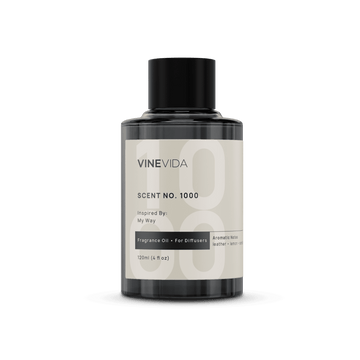Galbanum Essential Oil: Uses, Benefits, and Blends
Scientific Name: Ferula Galbaniflua
Origin: France
Plant Part: Resin
Scent: Green, herbal, sweet
Color: Green
Consistency: Thick and sticky
Perfumery Note: Middle to base. Has fixative qualities
Initial Aroma Strength: Middle to soft
Extraction Method: Steam distillation
Suitable Blending Oils: Galbanum Essential Oil blends well with oils such as Elemi, Rose, Jasmine, Lavender, Bergamot, Violet and Geranium, bringing a feeling of leafy outdoor business to a blend.
Breaking Down the Galbanum Essential Oil’s Chemical Components
Chemical Constituents: Monoterpenes (65-85%), a-pinene (45-50%), Camphene, Limonene, Myrcene, Carvone, Sesquiterpenols, Esters, Coumarins.
Historical Uses of Galbanum Essential Oil
Amongst classic choices like lavender, geranium, and myrrh, Galbanum Essential Oil is often somewhat overlooked. Despite that, it is wonderfully healing to the skin and respiratory systems and is a profound emotional and spiritual healer.
It has a romantic and important history. Yet its exotic name makes it tantalizingly difficult to place where it could have originated from. Many sources suggest Hebrew, and as we unravel its past you too may come to agree that’s likely.
This is not what you would call one of those oils it's imperative to have in your box, like lavender or geranium Essential Oils for example. Instead, galbanum Essential Oil lends ”finesse" to preparations, elevating them somehow.
Galbanum Essential Oil is one of those oils that move your practice up out of the novice space to skilled amateur.
Where Does Galbanum Essential Oil come from?
Galbanum Essential Oil is steam distilled from a resin of the Ferula Galbaniflua plant.
It is an umbelliferous plant, native to Northern India, Afghanistan, and Iran. It bears the family resemblance to Angelica (or perhaps more so, fennel) being tall, reedlike with tiny, pretty flowers and long shiny leaflets. The Ferula genus is the third largest family of umbellifera, with around 180 different members. Ferula asafoetida - commonly known as the herb asafoetida - is a close cousin.
Ferula Galbaniflua produces the product we know as galbanum. The secretes two types of resin, Levant or Soft Galbanum, and Persian or Hard Galbanum. Galbanum Essential Oil is steam-distilled from the soft galbanum resin. The species is also known by the synonym Ferula Gummosa.
The plant makes the resin to respond to injury. Essentially, it's the plant’s scab with a bit of antiseptic thrown in. The galbanum plant oozes milky sap to heal itself and to deter pathogens or insects from making it even more vulnerable. So, to cultivate it, a sharp cut is made to the base of the plant, near the root. Resin is released and then quickly air dries.
Hard galbanum is brittle. Soft galbanum is viscous tears that ooze, It’s usually the palest yellow right through to deep gold and usually with a greenish tinge, which softens in the warmth of your hand.
The most valuable tears are those that are the palest and break open to contain translucent white.
Distillation of Galbanum Essential Oil
In most cases though, tears are contaminated with sand, chips of wood, or insects that have come to sticky deaths. The yield then relies on how pure these tears are. In summer they can be softened and strained clear. Adding benzyl benzoate softens and makes the galbanum pourable and this is often used in perfumery, but the final extraction is usually done by distillation.
In The Modern Herbal, Mrs. Grieve describes a different extraction, revealing that galbanum Essential Oil which has undergone dry distillation, is a beautiful blue oil color comparable to chamomile Matricaria, but this no longer seems to be commercially available. Dry distillation is not as popular as it was when she wrote her book almost a century ago.
The Illustrious History of Galbanum
Hebrew
In Exodus 30 of the Bible, we read that galbanum appeared in the recipe of the Holy incense of the Hebrews.
“And the Lord said unto Moses, Take unto thee sweet spices, stacte, and onycha, and galbanum; these sweet spices with pure frankincense: of each, there shall be a like weight.” (Exodus 30:34)
Used as a means to purify the space of the Tabernacle the incense was used as a means to open the space to speak to God. The holy incense was believed to be free from evil and formed an essential part of the discourse between the deity and his chosen people.
In his commentary on the Talmud, the medieval rabbi Shlomo Yitzhaki (better known to many as Rashi) explained that he felt that Galbanum may have been included in the incense because it was bitter, so it would serve as a potent reminder for repeating and unrepentant sinners.
Egyptian
Dioscorides describes galbanum and being known to his Egyptian peers as Metopium. As a physician to Emperor Nero, Dioscorides was writing in the 1st century, but the Egyptians seem to have been using galbanum long before that. Chromatography analysis of resins found in an XII Dynasty Egyptian tomb identified galbanum as one of the ingredients. It is impossible to say for sure how it was used because it has so far not been found in any recipes, but it seems likely they used it for embalming.
It’s believed that it was used to anoint the forehead of the statue of Osiris to ensure a clear passage into the afterlife for the newly dead. That makes sense to me since Osiris is often depicted with a green face, perhaps in a bid to portray the putrefaction of the corpse as it decayed. One of the key uses for galbanum is to clear up infection and putrefaction. Galbanum incense does have a distinctly green fragrance to it- a bit like freshly mown grass.
Greek
Dioscorides also speaks of the "antispasmodic, diuretic, and pain-relieving properties" of galbanum oil. It should be stressed that while the report is correct, he is not speaking of the galbanum Essential Oil that we use today, rather it would have been galbanum resin soaked into a warm Carrier Oil or some kind of animal fat. That said, the description is still exactly right on all counts.
My favorite ancient reference comes from Pliny the Elder. In his work, Natural History, he speaks of the great curative powers of galbanum when he says.
The right Galbanum, if you burn it, chaseth away Serpents with the strong perfume or smoke thereof. It is sold for five deniers the pound: and is used only in Physicke for medicines.
In another section, he also writes,
"The very touch of it mixed with oil of spondylium [which is the plant, Common Hogweed] is sufficient to kill a serpent.
Sadly, he does not elucidate exactly how one would apply that…presumably with a very long stick!
He calls it “The Mother Resin”.
Roman
Throughout their Empire, the Romans continued to use galbanum as incense, and adopted its fresh green fragrance as their chosen way to greet Spring, burning it to cleanse the year and to honor their Goddess Flora.
Physical Properties Of Galbanum Essential Oil
Analgesic, anti-inflammatory, antiseptic, antispasmodic, digestive, emmenagogue, expectorate, restorative, tonic.
Energetics of Galbanum Essential Oil
In Traditional Persian Medicine, galbanum known by the name “Barijeh”, is used as an antispasmodic and stimulant. It has an invigorating effect and is used as a tonic.
Galbanum Essential Oil for Skin
Marguerite Maury was one of the foremost pioneers in aromatherapy. She rated galbanum Essential Oil for skin care and described blending it with violet leaf absolutely for mature skin.
Normally, you might expect the recommendation to use frankincense Essential Oil for mature skin, but to my mind, it has a different effect on the skin, somehow galbanum gives the skin a warmer, softer appearance. It is great to swap and change your oils, so this is a great way to experiment with galbanum Essential Oil for skin vs Frankincense Essential Oil.
However, Maury warns that galbanum Essential Oil is not suited to younger skins.
That said, being so rich in sesquiterpenes it encourages cell growth and so would make a terrific addition to treatments for acne if you are worried about scar tissue.
The Antitoxin Nature of Galbanum Essential Oil
We spoke earlier about how Pliny talked about galbanum and snakes.
Galbanum Essential Oil has wonderful anti-poison and antivenom properties (Dehghani, 2015). It forms the first stage of Theriac, the famous Roman panacea that was a cure-all including anti-poison. (Mostre, 2017)
The most famous tale is of Mithradates, who is reputed to have invented the medicine.
He is said to have taken small amounts of poison each day to build his tolerance against it and to protect himself against assassins. Then the poor man witnessed the executions of his daughters and tried to end his own life. So wonderful had been his efforts that he could not succeed in killing himself and eventually committed suicide with his sword.
Poison need not always be externally introduced, of course, the body is all too clever at producing it, itself. So, use galbanum for infected blisters, cuts, and tears.
It is a go-to oil if you are worried something is going to go septic.
If it is gunky, oozing… bleach…. You need galbanum Essential Oil. It is one of the effective treatments for abscesses and works very well to put galbanum Essential Oil on a warm compress to draw out toxins.
Likewise, use galbanum Essential Oil if there is something that could go nasty…cat scratches, for example, or even more so…thorns. Galbanum Essential Oil not only cleans the wound but drives the toxin (or thorn) back out from under the skin.
Galbanum Essential Oil for Belly Ache!
The question here is what kind of belly ache? Well, pretty much all types really, from stomach cramps to period pains or even griping kidneys.
Traditional Chinese Medicine says that Galbanum Essential Oil clears dampness and warms the stomach.
Local Iranian medicine suggests drinking galbanum Essential Oil in honey for kidney and urinary tract diseases and the removal of kidney stones. (Mohammadhosseini, 2018)
It can be a wonderful help for people suffering from symptoms of Irritable Bowel Syndrome. Traditional Chinese Medicine often sees IBS Symptoms as being manifestations of the liver overacting on the spleen.
In TCM, energy, or qi, is seen as running through the meridians. Most of these meridians flow vertically, but there are a couple where the energy moves horizontally. When this horizontal movement is too strong, it is described as Liver Qi being too rebellious, which then impairs the Spleen and prevents its energy from rising. The job of the spleen is to transform and transport food etc.
Thus if the spleen cannot transform food smoothly, we can expect to see this constipation diarrhea loop.
The key cause of liver qi being too rebellious is believed to be stress, or more specifically anger, frustration, and resentment. These are all Liver emotions that exhaust the liver over time.
Galbanum Essential Oil smooths the flow of Liver Qi.
So we can see that as a two-way door. Galbanum Essential Oil soothes stress and more specifically anger, resentment, and frustration as well as soothing peristalsis and the bowel. It is also wonderful as an anti-flatulent.
This review aims to investigate traditional and novel applications of this valuable plant. Relevant databases
Galbanum Essential Oil Moves Blood and Qi
It has a profound effect on circulation that can be leveraged in many ways.
Traditionally galbanum Essential Oil is also reported as a uterine tonic and is used in aromatherapy to treat both scanty menstruation and painful periods.
As seen, it has strong antispasmodic abilities which help with pain, but it also moves the blood, encouraging smoother flow and less pain.
It can be helpful for very clotted blood loss.
Because of the action upon the uterus, galbanum Essential Oil is contraindicated in pregnancy and indeed, Iranian midwives use it to encourage the body to dispel dead fetuses after miscarriage. (Mohammadhosseini, 2018)
In the same way, that galbanum moves blood, Iranian folk medicine says that if you drink galbanum resin dissolved in water for three sequential days, it can treat hemorrhoids. (Mohammadhosseini, 2018) A cream or massage oil applied topically can also be helpful.
Because of this action of moving blood, it may be helpful for varicose veins.
Galbanum Essential Oil For Aches And Pains
Galbanum Essential Oil is rich in alpha-pinene which is an extremely useful chemical constituent for pain.
Read More: Essential oil for aches.
Galbanum Essential Oil for Aches and Pains
Alpha pinene also has powerful effects on cartilage between the joints.
Cartilage is made up of cells known as chondrocytes.
These chondrocytes live inside the vertebrae discs of the spine and in the tissue lining of the joints.
The tissue is alive and provides cushioning to joints when they move.
Chondrocytes make cartilage stronger and more flexible. They are surrounded by collagen fibers to strengthen them. Chondrocytes also support healthy tissue repair after joint injuries.
Their capacity to heal means they could make exciting possibilities for healing in the future. Think about how cool it would be, if you could influence chondrocytes if someone has had their knee replaced, for instance. It might be a potential game changer for osteoarthritis therapies.
In 2014, pinene was identified as an exciting possibility, since it was demonstrated to have anti-inflammatory skills upon chondrocytes. (Rufino, 2014)
Galbanum Essential Oil For Nerve Pain
Again, we are interested in alpha-pinene here because it has also been proven as a therapeutic for neuropathic pain, specifically migraine. Pinene has anti-inflammatory properties and can modulate vasodilators. (Sun, 2017)
Similarly, in a sciatica model, pinene was deemed to have effects equal to the neuropathic pain medications traditionally prescribed by the doctor. (Quintão, 2010)
Interestingly, Pliny the Elder cited galbanum for sciatica almost 2000 years ago.
Pinene also has weak anti-nociceptive activity, (that means it switches pain signaling down) through its action on the mu opioid receptor.
In a rodent trial. Alpha pinene was shown to significantly increase the creatures’ pain thresholds. (Otto, 2011)
The study demonstrated that although the analgesic effects of alpha-pinene were executed through the same receptors that morphine uses, alpha-pinene’s actions were not as strong as morphine, unfortunately. Where it excelled though was the effects were much longer lasting. In this test, morphine exhibited a pain threshold of 30 minutes, but alpha-pinene was still showing analgesic protection as long as 150 minutes after application. (Him, 2008)
Studies also suggest the receptors involved in the analgesia are probably supraspinal, suggesting receptors send messages from the spinal cord to the brain. Consider too that chondrocytes are found in abundance in vertebrae. This may suggest the most effective way to use galbanum Essential Oil for pain is to do a back massage.
Galbanum Essential Oil for Respiratory Function
As seen, galbanum Essential Oil is a tonic and encourages things to move. In this case, it moves phlegm. It can be a wonderful help when combined with hyssop or myrrh to break down chest congestion, or with eucalyptus for bronchitis.
Galbanum Essential Oil For Memory
Galbanum Essential Oil may be helpful for people who are aging and suffering from the effects of neurodegeneration.
The effects of galbanum Essential Oil on memory have been known since at least medieval times. Tabernaemontanus was a 16th-century apothecary who then became a physician, and eventually became a physician to Phillip II. His detailed herbal of woodcut illustrations provided the basis for much of the more famous work of John Gerard. He describes how galbanum Essential Oil can be applied to the neck or drunk to improve memory, hearing, and sense of smell. (Tabernaemontanus, 1687)
Today, galbanum Essential Oil is being used in studies to try to identify possible future therapeutics for epilepsy. A recent rodent trial showed that mice who had been treated with galbanum Essential Oil had far fewer pentylenetetrazole-induced seizures. Their survival rates were higher, and their memory and confidence were left intact after the drug. (Bashiri-Nahnjeh, 2023)
The success was put down to the chemical constituency Sabinene which was able to bind to the binding site of benzodiazepines at the GABAA receptor. (Bashiri-Nahnjeh, 2023)
Its antispasmodic effects mean it is often also used to give relief to chorea. (Bashiri-Nahnjeh, 2023) Chorea is a movement disorder that causes sudden, unintended, and uncontrollable jerky movements of the arms, legs, and facial muscles. It is a symptom seen in many conditions and is triggered by dopamine overactivity of dopamine in the movement brain centers.
Using Galbanum Essential Oil For The Respiratory System
Galbanum is also a wonderful oil for helping you breathe.
It cuts through congestion of chest infections and seems to open the airways.
There is something about its viscosity that reminds you how good it will be for thick and oozing problems. We spoke of ulcers earlier, but you might also want to consider using galbanum Essential Oil to break down phlegm.
From another dimension, galbanum oil helps sufferers of asthma in that it releases the air passages, perhaps it was Dioscorides’s observation about what a good antispasmodic galbanum Essential Oil is.
Using Galbanum Essential Oil for the Digestive System
Galbanum is soothing and soothing for stomach cramps. Persian medicine uses it to reduce flatulence.
Galbanum Essential Oil Uses: For Wholesale Purposes
Aromatherapy
Beautifully soothing. Wonderful for when you feel a little stuck in life. This is also a tremendous oil for making you feel braver in the face of adversity, especially during spiritual work.
Natural Perfumery
Galbanum Essential Oil is a natural fixative and is a magical component in perfumery. Research shows that scents can last up to four times as long if they contain Galbanum oil blended into them.
There are very few true green notes in perfumery and galbanum Essential Oil is often used to bring a sultry, luxury note to Chypres perfumes and body to fougéres.
Most notably, Cartier’s fragrance "Must" has galbanum Essential Oil in the spotlight of their blend.
Galbanum Essential Oil Blends: DIY Recipes
Galbanum Essential Oil Blend for Wound Healing
- 19 ml Tamanu Carrier Oil (Calophyllum Inophyllum)
- 3 drops Galbanum Essential Oil (Ferula Galbaniflua)
- 5 drops Helichrysum Essential Oil (Helichrysum Splendida)
- 3 drops Roman Chamomile Essential Oil (Anthemis Nobilis L.)
Method of Preparation: Add the Essential Oils to the Tamanu Carrier Oil and combine well.
Method of Use: Massage gently around the affected area. Use up to 8 times a day.
Safety: Not suitable for use during pregnancy.
Helichrysum Specific -Blood thinning - Not suitable for use for people who have platelet disorders or are on blood thinning medication. It is suggested you cease the use of Helichrysum Essential Oil 48 hours before any planned surgery.
Galbanum Essential Oil Blend for IBS
- 19 ml Grapeseed Carrier Oil (Vitis Vinifera)
- 5 drops Galbanum Essential Oil (Ferula Galbaniflua)
- 3 drops Cilantro Leaf Essential Oil (Coriandrum Sativum L)
- 2 drops Black Pepper Essential Oil (Piper Nigrum)
Method of Preparation: Add the Essential Oils to the Grapeseed Carrier Oil and combine well.
Method of Use: Massage gently into the lower abdomen and lower back. It can also be used at the pulse point at the wrist and inner elbows. Use up to 8 times a day.
Safety: Not suitable for use during pregnancy.
Galbanum Essential Oil Blend for Neuropathic Pain
-
- 19 ml Grapeseed Carrier Oil (Vitis Vinifera)
- 5 drops Galbanum Essential Oil (Ferula Galbaniflua)
- 5 drops Rose Otto Essential Oil (Rosa Damascena)
- 1 drop Bergamot Essential Oil (Citrus Bergamia)
Method of Preparation: Add the Essential Oils to the Grapeseed Carrier Oil and combine well.
Method of Use: Massage gently into the affected area. It can also be used at the pulse point at the wrist and inner elbows. Use up to 8 times a day.
Safety: Not suitable for use during pregnancy.
Galbanum Essential Oil Serum for Mature Skin
-
- 25 ml Jojoba Carrier Oil (Simmondsia Chinensis)
- 20 ml Argan Carrier Oil (Argania Spinosa)
- 5 ml Rosehip Carrier Oil (Rosa Canina)
- 4 drops Galbanum Essential Oil (Ferula Galbaniflua)
- 4 drops of Rose Otto Essential Oil (Rosa Damascena)
- 2 drops Violet Leaf Absolute Oil (Viola Ordorata L.)
- 2 drops Ylang Ylang Essential Oil (Cananga Odorata)
Safety: Not suitable for use during pregnancy.
Method of Preparation: Combine the Carrier Oils and then add the Essential Oils. Combine well and mix thoroughly
Method of Use: Decant into a serum dispenser and massage gently into the skin of the face, neck, and decolletage. Use small upward, circular motions. Massaging the skin well promotes blood flow, improves circulation, and encourages cell renewal. Use 2-3 times a week.
Precautions
Not suitable for use during pregnancy.
Why Choose VINEVIDA
At VINEVIDA, we love botanicals and the planet they come from. We believe in stocking the best at affordable prices and supplying to the discerning, which is why we are also members of both the Alliance of International Aromatherapists and the National Association of Holistic Aromatherapy. In recognition of our excellent standard of product, we are proud to hold a 2021 Certificate of Registration as a Cosmetic Products Establishment with the U.S. Drugs and Food Administration.
Our joy at seeing people make beautiful things means we stock from the smallest amounts to the largest. Our bulk Essential Oils prices begin with our smallest Essential Oil of 10ml to our largest of 396lb, meaning any manufacturing company can afford to stock as many or as few oils as their business can accommodate without running the risk of spoilage of some of nature’s most precious commodities. So why not see if you can save money by buying your Galbanum Essential Oil in bulk? Remember how stable it is proven to be, so as long as you store it carefully, it should last and last.
Don’t forget too, we like to look after our customers with reasonable prices and excellent customer service and reward the loyal ones with money-off discounts over the year.
Conclusion
So, why not check out if you qualify for our loyalty scheme and start saving today with an environmentally friendly choice of oil for skin, hair, massage oils, and soap making? Add VINEVIDA Galbanum Essential Oil to your cart today.

You may also like
Recently viewed

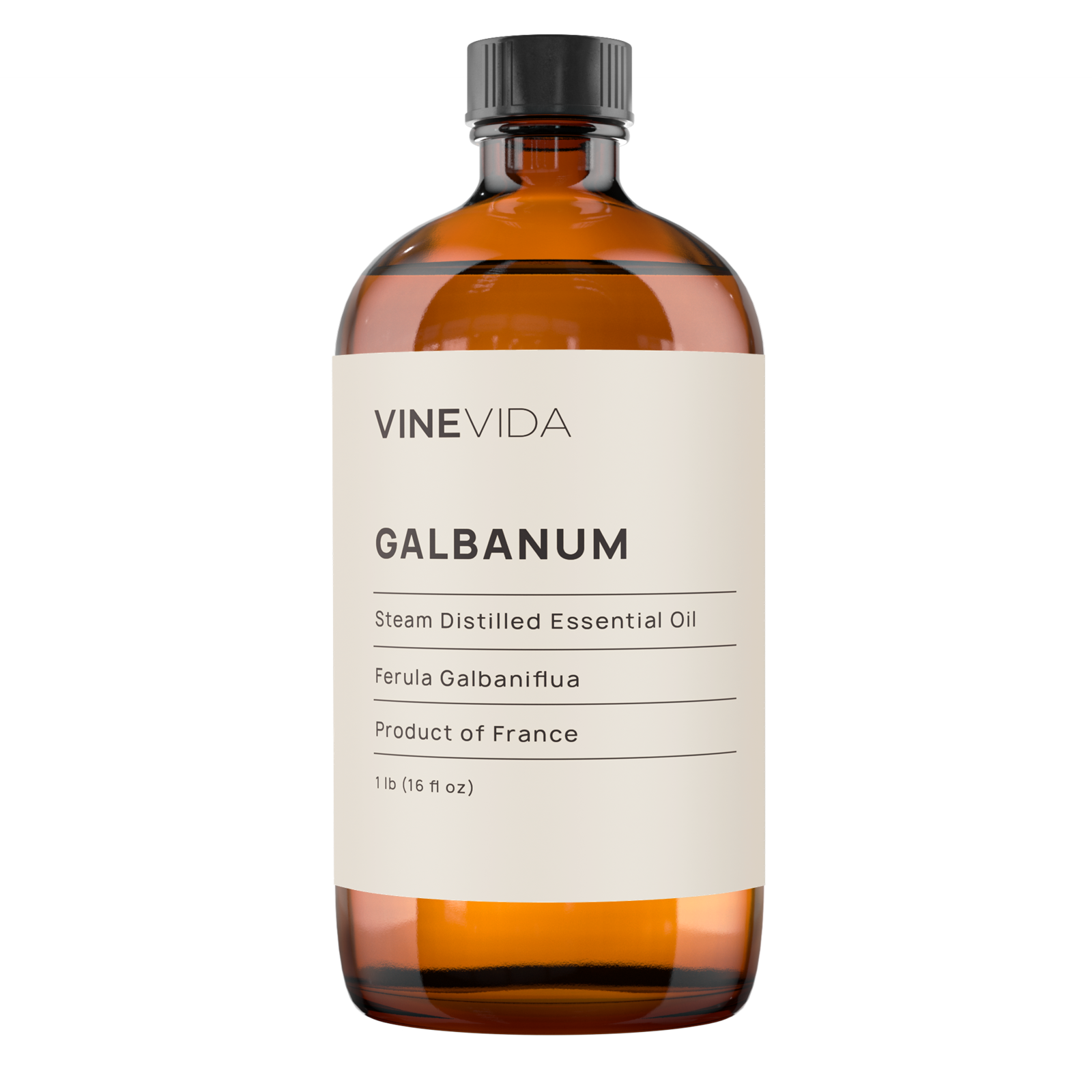
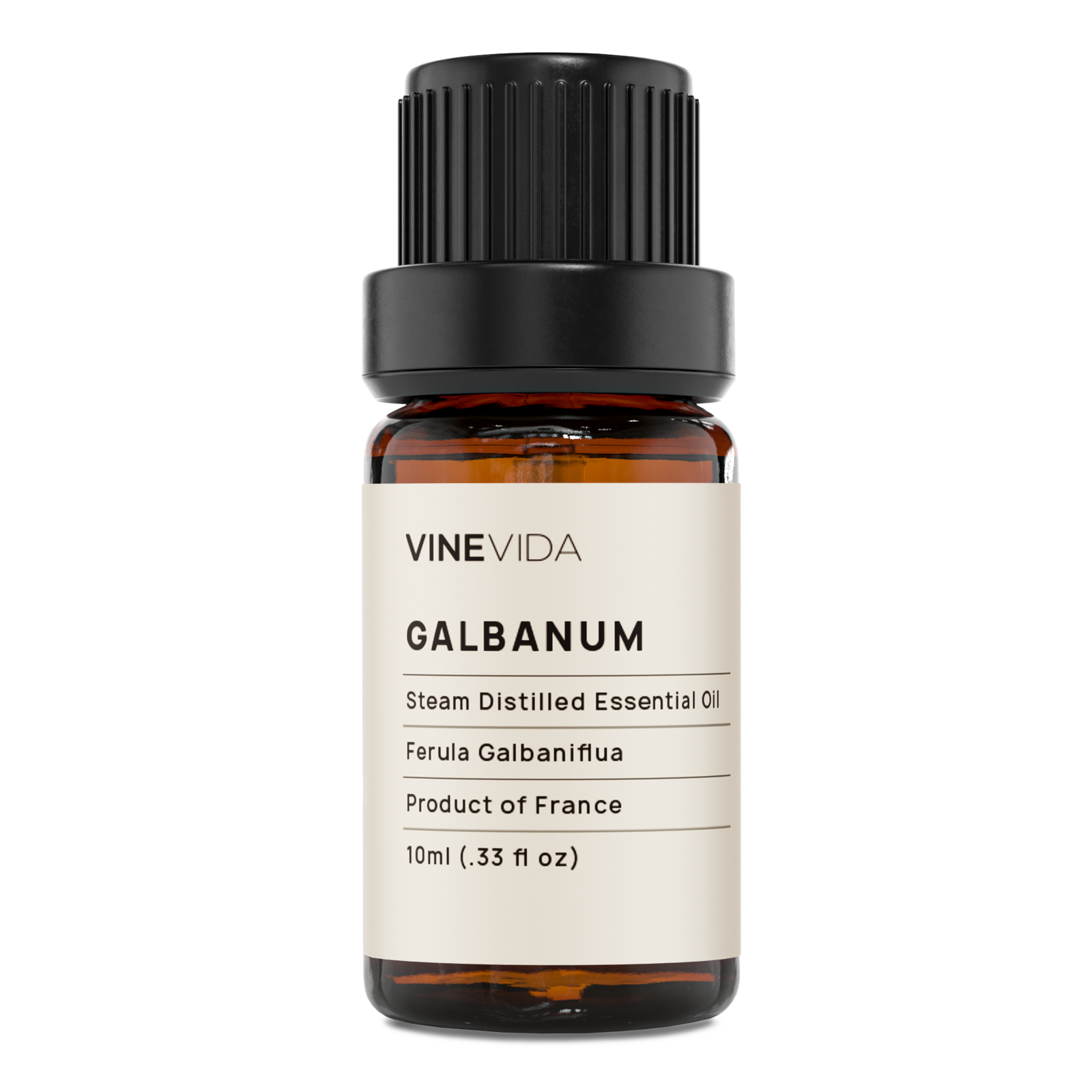
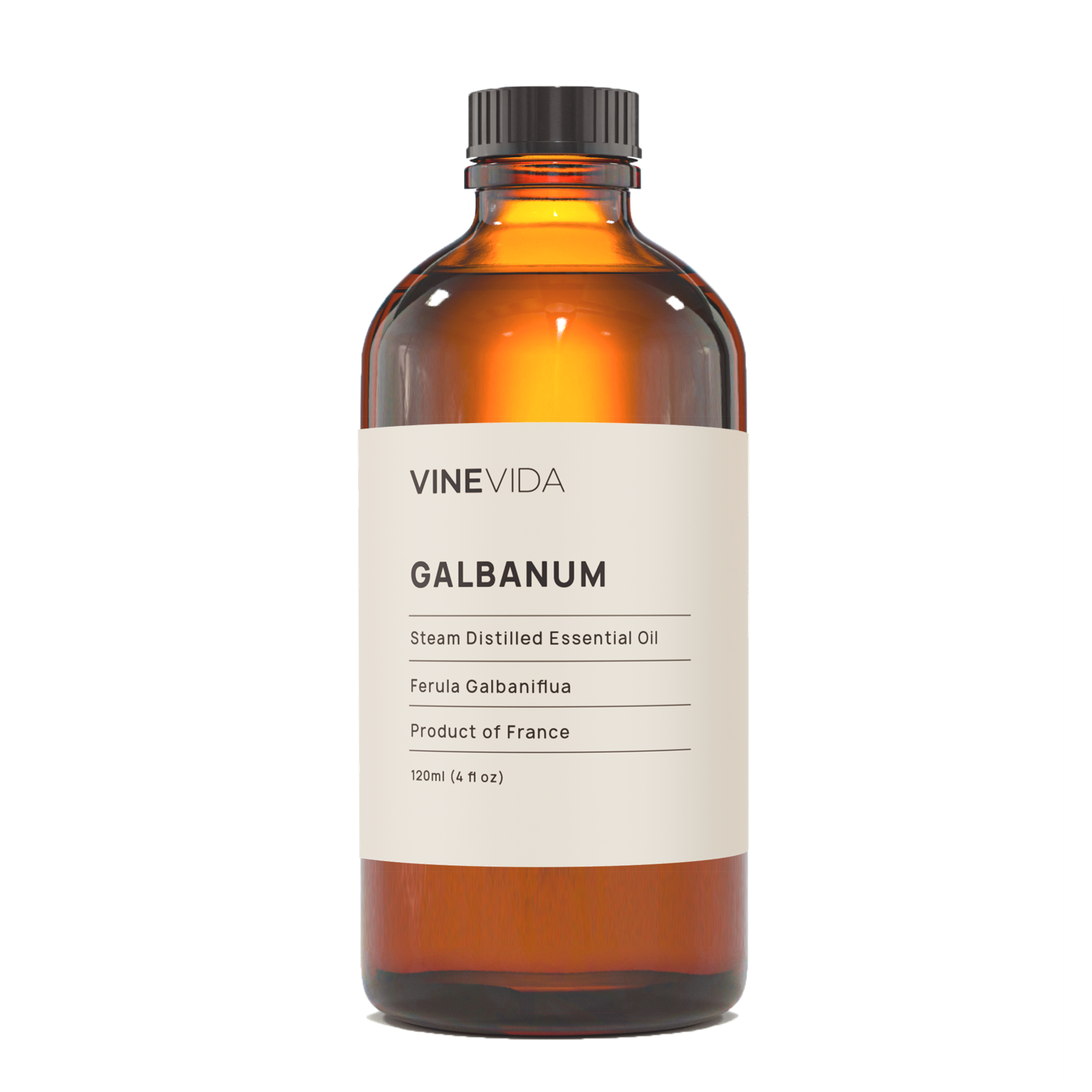
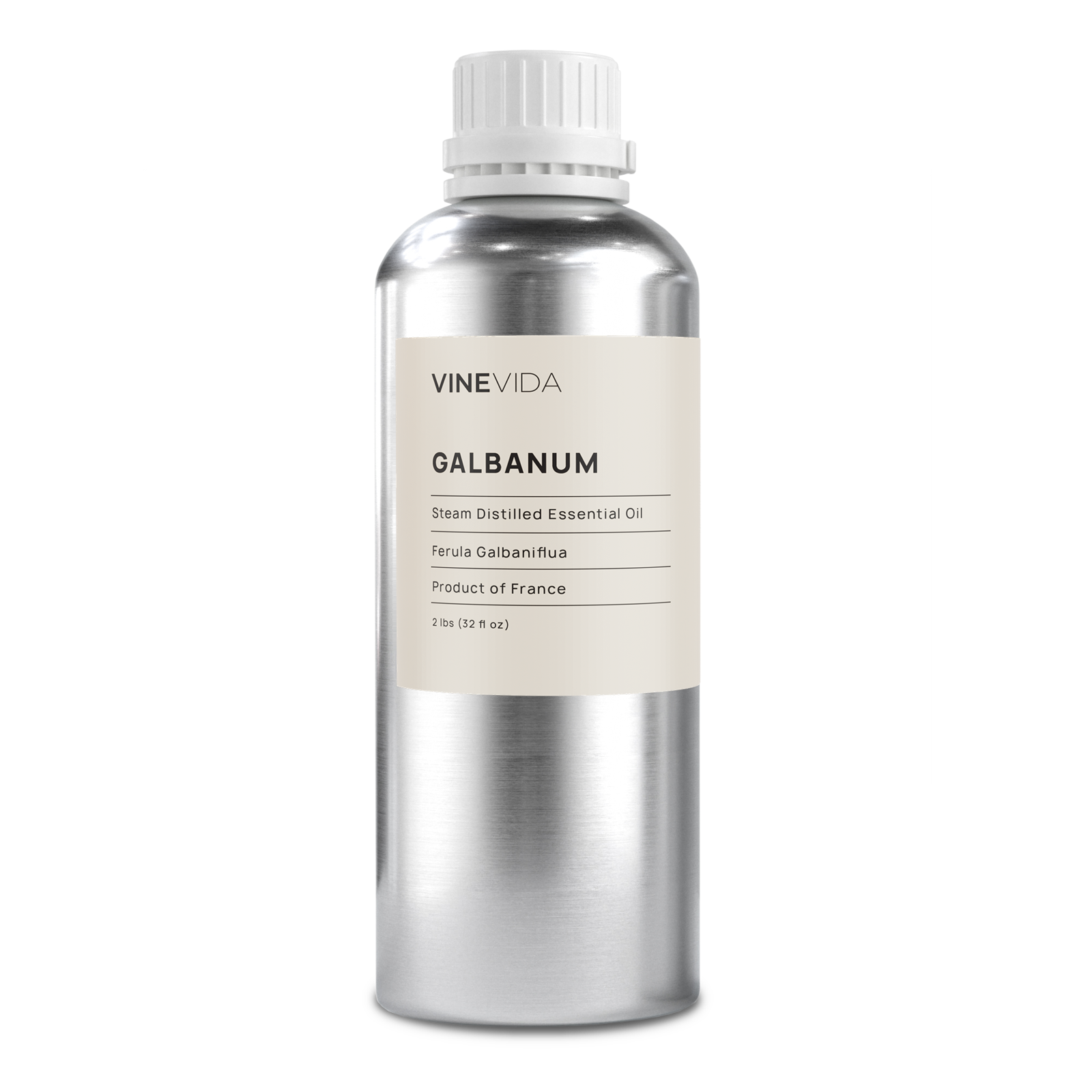
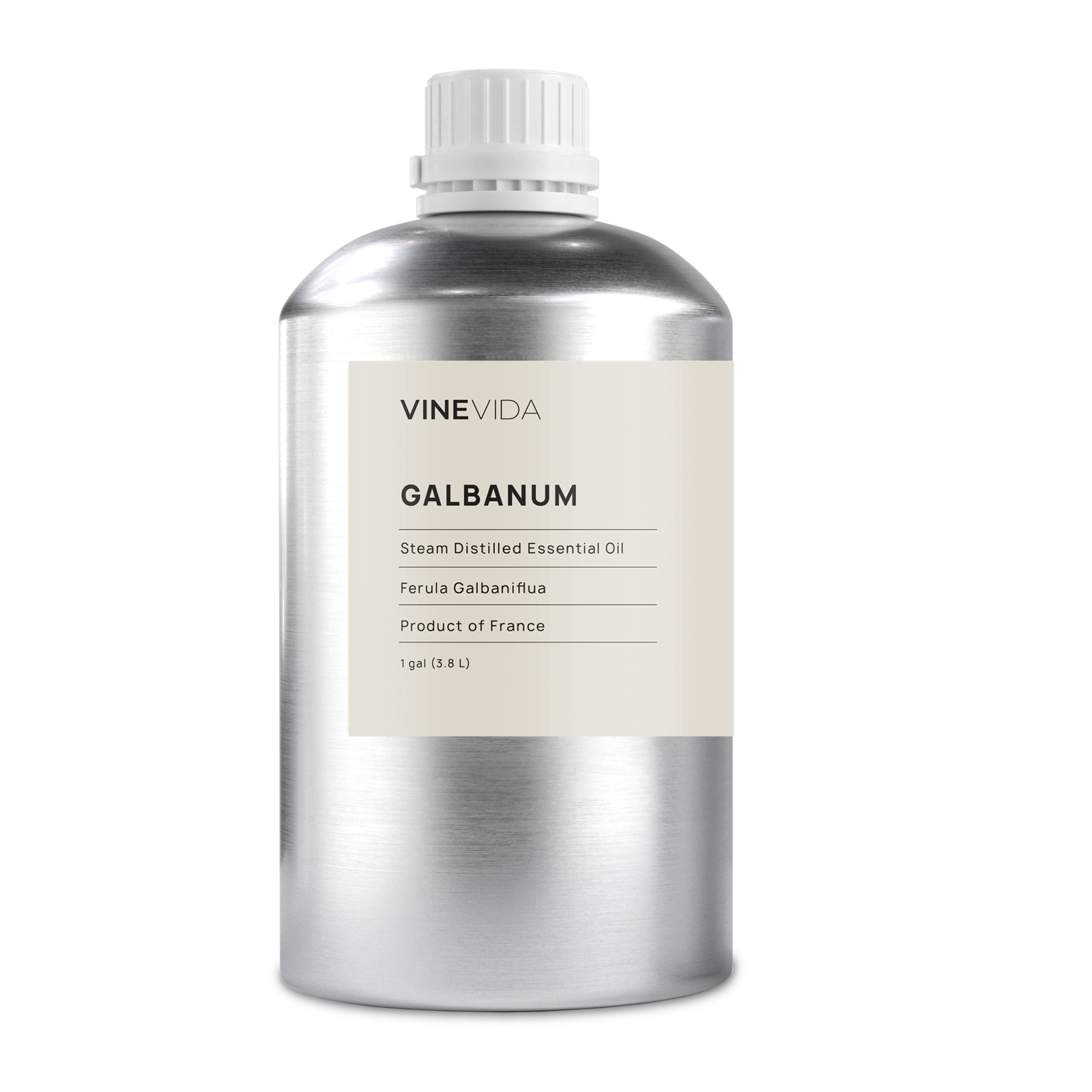
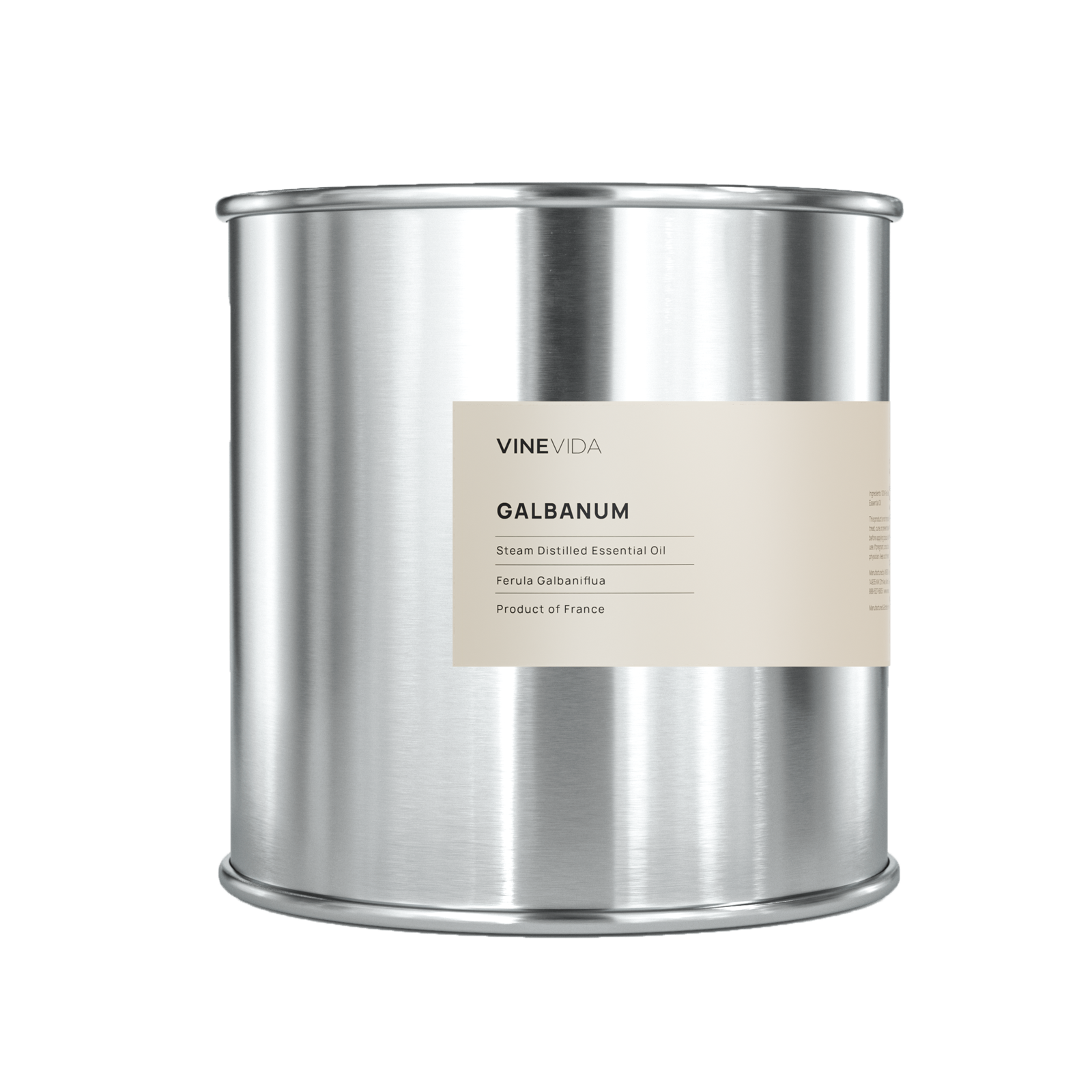
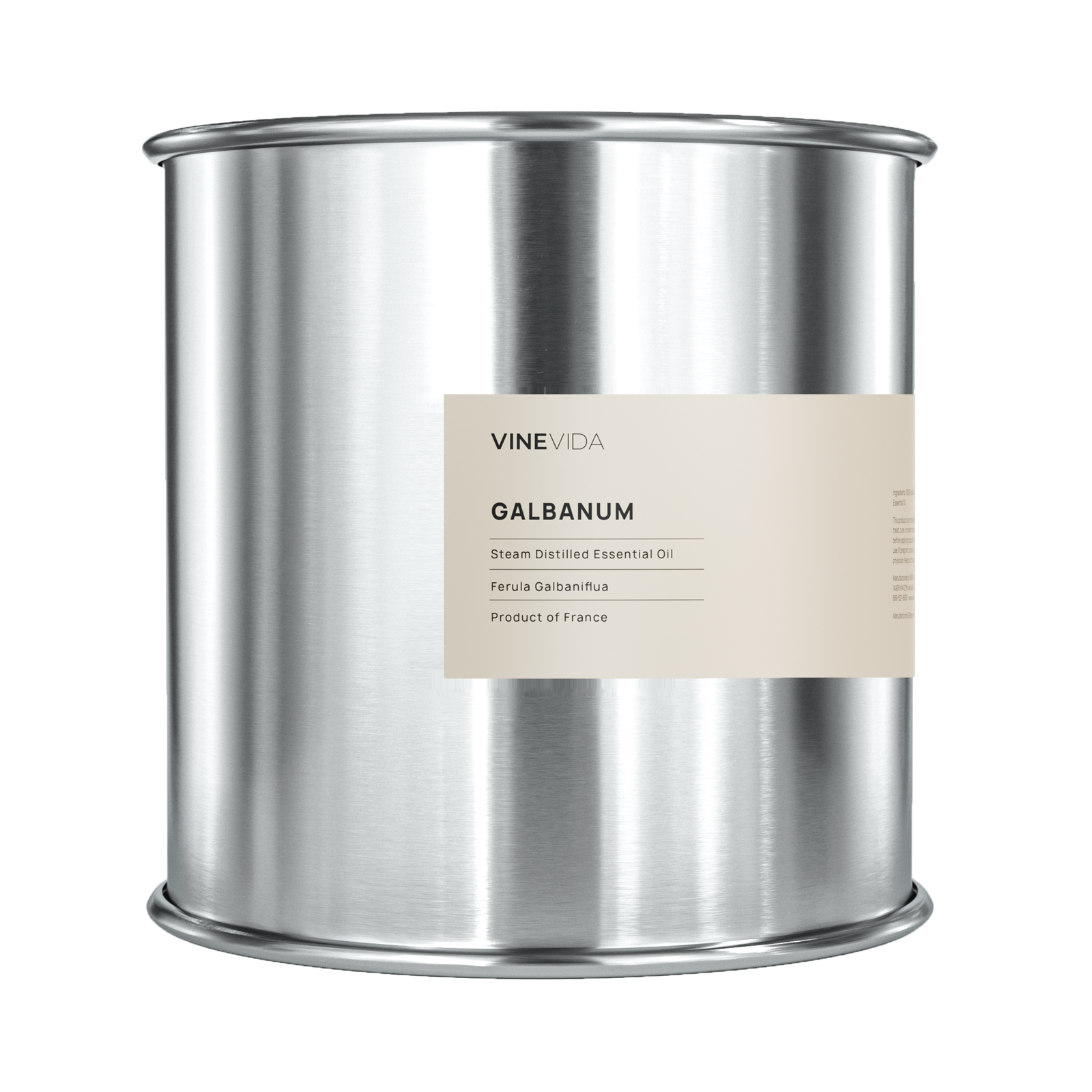
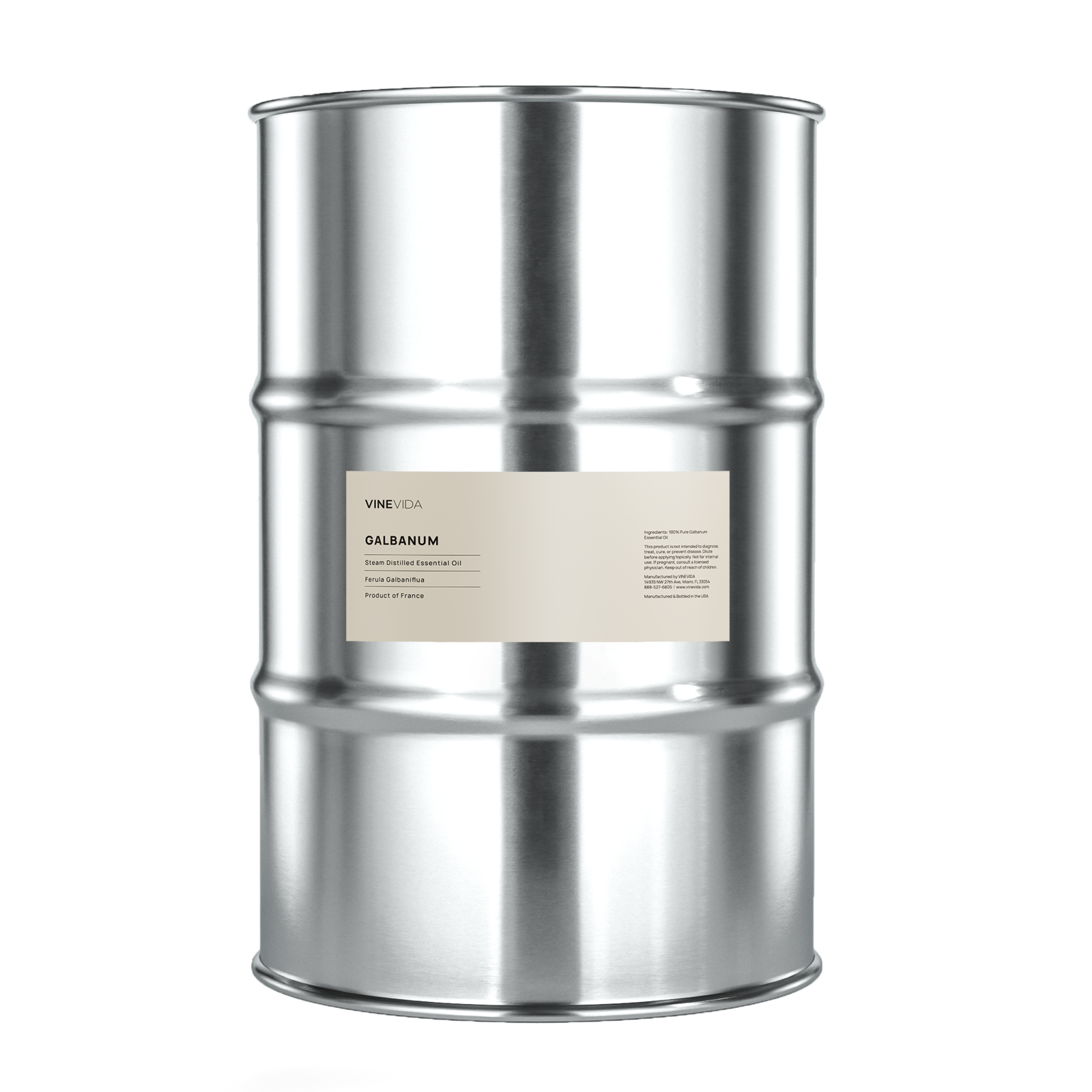




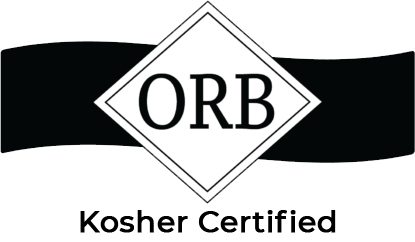
 Certificate of Analysis
Certificate of Analysis
















